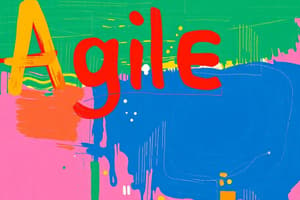Podcast
Questions and Answers
What is the most efficient and effective method of conveying information?
What is the most efficient and effective method of conveying information?
Face-to-face conversation.
Working software is not the primary measure of progress.
Working software is not the primary measure of progress.
False (B)
What does agility refer to in software development?
What does agility refer to in software development?
The ability to respond to changing requirements and environments quickly and efficiently.
Which of the following are key characteristics of agility? (Select all that apply)
Which of the following are key characteristics of agility? (Select all that apply)
What is the primary purpose of the Agile process model?
What is the primary purpose of the Agile process model?
What does XP stand for in Extreme Programming?
What does XP stand for in Extreme Programming?
Which of the following is NOT a core value of Extreme Programming? (Select one)
Which of the following is NOT a core value of Extreme Programming? (Select one)
Match the phases of the Extreme Programming Life Cycle with their descriptions:
Match the phases of the Extreme Programming Life Cycle with their descriptions:
Scrum is a ___ framework that emphasizes self-organization.
Scrum is a ___ framework that emphasizes self-organization.
What is the purpose of a Sprint in Scrum?
What is the purpose of a Sprint in Scrum?
What does Kanban focus on?
What does Kanban focus on?
Which tool is widely used for Agile project management?
Which tool is widely used for Agile project management?
What is software engineering?
What is software engineering?
Which of the following are characteristics of software models? (Select all that apply)
Which of the following are characteristics of software models? (Select all that apply)
What are the 6 components of software?
What are the 6 components of software?
What does usability refer to in software?
What does usability refer to in software?
Identify an advantage of the Waterfall Model.
Identify an advantage of the Waterfall Model.
What is the main purpose of the testing phase in the Waterfall Model?
What is the main purpose of the testing phase in the Waterfall Model?
In the Waterfall Model, phases can overlap.
In the Waterfall Model, phases can overlap.
Which of the following is not a phase of the Waterfall Model?
Which of the following is not a phase of the Waterfall Model?
What is a key characteristic of the Incremental Model?
What is a key characteristic of the Incremental Model?
Which model emphasizes iterative development and flexibility?
Which model emphasizes iterative development and flexibility?
What is the focus of Agile development?
What is the focus of Agile development?
Match the following models to their characteristics:
Match the following models to their characteristics:
Flashcards are hidden until you start studying
Study Notes
Software Engineering Overview
- Software Engineering involves designing, developing, testing, and maintaining software systematically to create high-quality and reliable systems.
- Primarily applied to large software projects rather than individual applications.
Characteristics of Software
- Intangible: Software cannot be physically touched or seen.
- Replicable: Easy to copy and distribute.
- Complexity: Understanding and modifying large systems can be challenging.
- Adaptability: Software must evolve based on changing user needs.
Key Components of Software
- Functionality: Features like data storage, processing, user interfaces, communication, and security.
- Reliability: Ability to perform intended functions consistently; relies on accurate coding and thorough testing.
- Efficiency: Optimal use of system resources such as memory and bandwidth, minimizing latency.
- Usability: Ease of use; low learning curve required for new users.
- Maintainability: Ease of making modifications to improve functionality or fix errors.
- Portability: Ability to move software between environments with minimal changes.
Applications of Software
- System Software
- Real-time Software
- Business Software
- Engineering and Scientific Software
- Embedded Software
- Personal Computer Software
- Web-Based Software
- Artificial Intelligence Software
Layered Technology in Software Engineering
- Comprised of interconnected layers including:
- Quality Focus: Continuous improvement principles, security, maintainability, and usability.
- Process: Foundation capturing all activities for timely software development.
- Method: Addresses “how-to-do” questions across various tasks.
- Tools: Enable integration and usage of information across processes.
Generic View of Software Engineering
- Definition Phase:
- Requirements gathering, feasibility study, specification documentation (e.g., SRS).
- Development Phase:
- System design, coding implementation, and rigorous testing.
- Maintenance Phase:
- Includes corrective, adaptive, perfective, and preventive maintenance.
Software Process Models
-
Waterfall Model:
- Linear and sequential approach; phases must be completed before moving forward, with no overlap.
- Phases: Requirements, Design, Development, Testing, Deployment, Maintenance.
- Advantages: Simple, clear milestones, strong documentation.
- Disadvantages: Inflexible to changes and potential late testing issues.
-
Incremental Model:
- Develops software in small, manageable increments, allowing continuous feedback and adaptation.
- Phases include communication, planning, modeling, construction, and deployment.
- Advantages: Flexible, less expensive changes, easier testing.
- Disadvantages: Ongoing management effort, higher overall costs.
Evolutionary Process Models
- Designed for accommodating changes; includes:
- Prototype Model: Initial prototypes guide development, with user feedback gathered for revisions.
- Spiral Model: Iterative approach with risk management at each phase. Each spiral loop includes objectives, risk resolution, development, and review.
- Concurrent Development Model: Parallel activities across phases, allowing simultaneous progress and adaptation to changes.
Agile Development
- Emphasizes iterative development, customer feedback, and flexibility in changing requirements.
- Key principles include customer satisfaction, frequent delivery, collaboration, and face-to-face communication.
Characteristics of Agility
- Flexibility to adapt, rapid software delivery, continuous customer involvement, strong collaboration, and ongoing process improvements.
Agile Process Model
- Combines iterative and incremental approaches for quicker adaptation during development processes.
Extreme Programming (XP)
- Focuses on technical excellence and rapid development with core values including communication, simplicity, feedback, courage, and respect.
- Life Cycle of XP: Includes planning, coding, testing, and frequent iterations for refinement based on user feedback.### User Stories and Definitions
- Clients outline their needs through brief descriptions known as user stories.
- Effort for each user story is estimated by the team, which schedules releases based on priority and effort.
Design Phase
- Essential design is only created for current user stories.
- A common analogy or story helps the team understand system architecture clearly.
Coding Phase
- Pair programming is promoted, where two developers collaborate at one workstation to improve code quality.
- Test-Driven Development (TDD) is practiced by writing tests before the actual code to ensure functionality.
Testing Phase
- Emphasis is placed on testing, including both automated unit tests and customer-led acceptance tests.
- Unit tests verify specific features, while acceptance tests determine if the overall system meets requirements.
Listening Phase
- Regular customer feedback is gathered to ensure the product meets needs and adapts to changes.
Key Practices of Extreme Programming
- Pair Programming: Enhances code quality and knowledge sharing through collaboration at one workstation.
- Test-Driven Development (TDD): Ensures code is verified through tests written prior to coding.
- Refactoring: Continuously improves the codebase without altering functionality, focusing on simplifying code and enhancing maintainability.
Agile Process Models
Scrum
- A management framework allowing teams to self-organize and tackle complex problems effectively.
- Features include lightweight structure, self-organization, simplicity, and enhanced teamwork.
- Lifecycle of Scrum:
- Sprint: A time-boxed period (one month or less) where a new sprint starts immediately after the previous one.
- Release: Final stage when the product is deemed complete.
- Sprint Review: Evaluates features that may not be achievable and leads to the Sprint Retrospective.
- Sprint Retrospective: Assesses product quality or status.
- Sprint Backlog: Comprises features assigned to sprints along with sprint planning.
Kanban
- Visualizes workflow while limiting work in progress to streamline the work process.
- Focuses on continuous delivery, allowing features to be released as they are ready.
Lean Software Development
- Prioritizes customer value delivery, waste elimination, and continuous improvement.
- Encourages collaboration with customers, shortened feedback loops, and team empowerment.
Crystal
- Customizes methodology based on specific project, team, and organization characteristics.
- Offers various "colors" or variants (e.g., Clear, Yellow, Orange) tailored to different project types.
Dynamic Systems Development Method (DSDM)
- An Agile framework ensuring project delivery is on time and within budget without compromising quality.
- Specific roles are defined, including Executive Sponsor, Project Manager, and Solution Developer.
Feature-Driven Development (FDD)
- An iterative and incremental process focusing on feature design and domain object modeling.
Tools for Agile Development
- Various tools enhance collaboration, project management, and continuous integration:
- JIRA: Supports Agile project management, including Scrum and Kanban boards and backlog management.
- Trello: Organizes tasks through visual boards, lists, and cards.
- Asana: Aids teams in tracking, managing, and organizing their work.
- Azure DevOps: Provides a set of development tools for version control and project tracking.
- GitHub: Facilitates version control and collaboration, supporting Git repositories and code reviews.
- Slack: Enhances team communication with real-time messaging and file sharing.
Studying That Suits You
Use AI to generate personalized quizzes and flashcards to suit your learning preferences.




